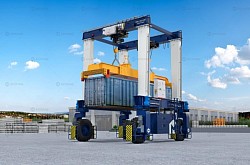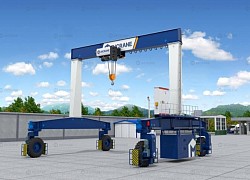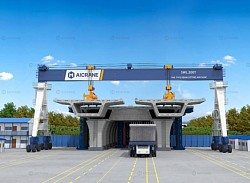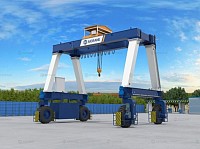Overview of RTG Crane Lifting Mechanism
Rubber tyred gantry cranes (RTG cranes) have become an essential lifting solution across a wide range of industries, including shipping container terminals, precast concrete yards, steel processing plants, and construction material storage sites. Their mobility, flexibility, and adaptability make them a preferred choice for operations that require efficient and flexible material handling without fixed rail infrastructure.
A critical component that defines the performance, safety, and versatility of RTG cranes is the lifting mechanism. The lifting mechanism is responsible for raising, lowering, and accurately positioning loads of various sizes and weights. This article explores the different types of lifting mechanisms used in rubber tyred gantry cranes, how they work, their advantages, and how to choose the right type based on application needs.
The lifting mechanism in an RTG crane generally consists of the hoisting winch, wire rope or chain system, motor drive, and load-handling device (such as a hook, spreader beam, or specialized attachment). It forms the core system that enables the crane to lift and lower loads safely and effectively.
Depending on the application and design, lifting mechanisms in RTG cranes can be categorized based on:
Drive type (Electric or Hydraulic)
Load handling device (Hook, Spreader, Beam)
Hoist configuration (Single or Twin hoist)
Control system (Manual, Semi-automatic, Automatic)
Let’s dive deeper into each of these classifications.
Electric Lifting Mechanism
How it works:
Electric lifting mechanisms use an electric motor to drive the hoist. The motor powers a drum around which wire rope is wound. As the drum rotates, the rope lifts or lowers the load attached to it.
Features:
Powered by diesel generators or electric power cables (in electric RTG cranes)
Common in container handling and light to medium-duty lifting
Paired with Variable Frequency Drives (VFDs) for precise control
Suitable for automatic and semi-automatic operation modes
Advantages:
Energy-efficient: Especially when connected to a grid or hybrid power system
Low noise: Compared to hydraulic systems
Precision control: Smooth acceleration and deceleration
Applications:
Container yards
Indoor/outdoor warehouses
Precast concrete manufacturing
Hydraulic Lifting Mechanism
How it works:
Hydraulic lifting mechanisms use pressurized hydraulic fluid to drive pistons or hydraulic motors that in turn power the hoist system. These systems are usually powered by a diesel engine with a hydraulic pump.
Features:
More robust for heavy-duty lifting
Preferred where high torque is needed at low speeds
Simpler in structure for some specific lifting configurations
Advantages:
High lifting power in compact form
Stable performance in rugged environments
Better overload tolerance
Applications:
Steel and heavy machinery yards
Off-road or uneven terrain operations
Shipyards
Hoisting Winch System
Winch-Based Hoisting:
Most RTG mobile gantry cranes use a winch-based system where a large drum winds or unwinds steel wire rope. This system can be single-drum or twin-drum based on the load requirement and redundancy.
Key Elements:
Hoisting motor (electric or hydraulic)
Gearbox for torque control
Wire rope drum
Limit switches for top and bottom positions
Benefits:
High load capacity
Long lifting height capability
Precise control with VFD integration
Chain Hoist Mechanism (Less Common in RTGs)
While rare, some smaller rubber tyred gantry cranes for light loads may utilize chain hoists instead of wire rope systems. These are typically used in compact environments or for lifting small components.
Advantages:
Lower cost
Simple maintenance
Compact size
Limitations:
Limited lifting height
Lower lifting speed and capacity
Load Handling Devices
The lifting mechanism is only as effective as the load handling device it is connected to. RTG cranes can be fitted with various attachments depending on the lifting application:
a) Hook
The most versatile and widely used attachment
Suitable for general lifting tasks like steel coils, construction materials, machinery
b) Spreader Beam
Used in container handling operations
Adjustable spreaders for 20ft, 40ft, and 45ft containers
Locking twistlocks ensure secure container lifting
c) Custom Lifting Beams and Slings
Designed for precast concrete segments, large pipes, or non-standard loads
Often used with dual hoisting mechanisms for load balance
Single vs. Twin Hoisting Mechanisms
RTG cranes can be equipped with one or two hoisting mechanisms depending on lifting needs.
Single Hoist
Suitable for symmetrical loads
Simpler control system
Lower cost
Twin Hoist (Synchronous Lifting)
Ideal for long or asymmetrical loads
Both hoists can lift simultaneously or independently
Used in beam lifting, bridge construction, and heavy industrial applications
Anti-Sway Control in Lifting Mechanisms
One of the modern innovations in RTG crane lifting mechanisms is the integration of anti-sway technology. This feature reduces load swing during lifting and movement, significantly improving safety and positioning accuracy.
Methods:
Active anti-sway via sensors and control algorithms
Passive anti-sway using dampers or pendulum-restricting systems
The lifting mechanism is a fundamental aspect of rubber tyred gantry cranes that determines their lifting performance, adaptability, and safety. Whether it’s a high-torque hydraulic hoist for heavy-duty construction or a precision electric winch system for container handling, the right choice of lifting mechanism can maximize operational efficiency and reduce risk.
With advancements in smart control systems, anti-sway technology, and eco-friendly power options, modern RTG cranes are becoming more intelligent, energy-efficient, and application-specific than ever before. Understanding the types of lifting mechanisms available and their respective benefits allows users to make informed decisions that align with their operational goals and budget.




